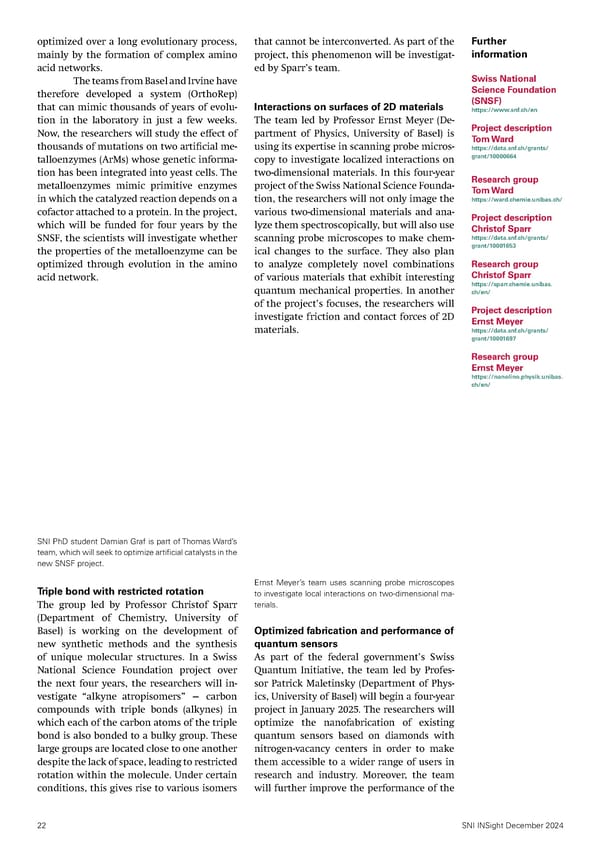optimized over a long evolutionary process, that cannot be interconverted. As part of the Further mainly by the formation of complex amino project, this phenomenon will be investigat- information acid networks. ed by Sparr’s team. The teams from Basel and Irvine have Swiss National therefore developed a system (OrthoRep) Science Foundation that can mimic thousands of years of evolu- Interactions on surfaces of 2D materials (SNSF) https://www.snf.ch/en tion in the laboratory in just a few weeks. The team led by Professor Ernst Meyer (De- Project description Now, the researchers will study the e昀昀ect of partment of Physics, University of Basel) is Tom Ward thousands of mutations on two arti昀椀cial me- using its expertise in scanning probe micros- https://data.snf.ch/grants/ talloenzymes (ArMs) whose genetic informa- copy to investigate localized interactions on grant/10000664 tion has been integrated into yeast cells. The two-dimensional materials. In this four-year Research group metalloenzymes mimic primitive enzymes project of the Swiss National Science Founda- Tom Ward in which the catalyzed reaction depends on a tion, the researchers will not only image the https://ward.chemie.unibas.ch/ cofactor attached to a protein. In the project, various two-dimensional materials and ana- Project description which will be funded for four years by the lyze them spectroscopically, but will also use Christof Sparr SNSF, the scientists will investigate whether scanning probe microscopes to make chem- https://data.snf.ch/grants/ the properties of the metalloenzyme can be ical changes to the surface. They also plan grant/10001653 optimized through evolution in the amino to analyze completely novel combinations Research group acid network. of various materials that exhibit interesting Christof Sparr quantum mechanical properties. In another https://sparr.chemie.unibas. ch/en/ of the project’s focuses, the researchers will Project description investigate friction and contact forces of 2D Ernst Meyer materials. https://data.snf.ch/grants/ grant/10001697 Research group Ernst Meyer https://nanolino.physik.unibas. ch/en/ SNI PhD student Damian Graf is part of Thomas Ward’s team, which will seek to optimize arti昀椀cial catalysts in the new SNSF project. Ernst Meyer’s team uses scanning probe microscopes Triple bond with restricted rotation to investigate local interactions on two-dimensional ma- The group led by Professor Christof Sparr terials. (Department of Chemistry, University of Basel) is working on the development of Optimized fabrication and performance of new synthetic methods and the synthesis quantum sensors of unique molecular structures. In a Swiss As part of the federal government’s Swiss National Science Foundation project over Quantum Initiative, the team led by Profes- the next four years, the researchers will in- sor Patrick Maletinsky (Department of Phys- vestigate “alkyne atropisomers” — carbon ics, University of Basel) will begin a four-year compounds with triple bonds (alkynes) in project in January 2025. The researchers will which each of the carbon atoms of the triple optimize the nanofabrication of existing bond is also bonded to a bulky group. These quantum sensors based on diamonds with large groups are located close to one another nitrogen-vacancy centers in order to make despite the lack of space, leading to restricted them accessible to a wider range of users in rotation within the molecule. Under certain research and industry. Moreover, the team conditions, this gives rise to various isomers will further improve the performance of the 22 SNI INSight December 2024
 SNI INSight December 2024 Page 21 Page 23
SNI INSight December 2024 Page 21 Page 23